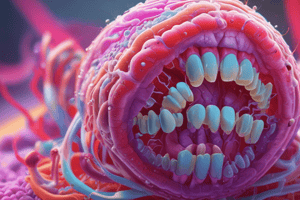Podcast
Questions and Answers
Which of the following is a characteristic of prokaryotic cells?
Which of the following is a characteristic of prokaryotic cells?
- They have a nucleus.
- They contain membrane-bound organelles.
- They lack a defined nucleus. (correct)
- They are generally more complex than eukaryotic cells.
The digestive system is responsible for gas exchange in the body.
The digestive system is responsible for gas exchange in the body.
False (B)
What is the main function of mitochondria in a cell?
What is the main function of mitochondria in a cell?
Energy production
In Mendelian genetics, the physical expression of traits is called the ______.
In Mendelian genetics, the physical expression of traits is called the ______.
Match the following organ systems with their primary functions:
Match the following organ systems with their primary functions:
Which technique is primarily used for amplifying DNA for analysis?
Which technique is primarily used for amplifying DNA for analysis?
Antibiotic resistance refers to bacteria becoming more susceptible to antibiotic treatment.
Antibiotic resistance refers to bacteria becoming more susceptible to antibiotic treatment.
Name the four types of microorganisms mentioned.
Name the four types of microorganisms mentioned.
The male and female structures in the reproductive system are involved in _______.
The male and female structures in the reproductive system are involved in _______.
Match the body systems with their corresponding functions:
Match the body systems with their corresponding functions:
Flashcards are hidden until you start studying
Study Notes
NEET - Biology Concepts
1. Cell Biology
- Cell Structure: Prokaryotic vs Eukaryotic cells.
- Prokaryotic: No nucleus, simple structure (e.g., bacteria).
- Eukaryotic: Nucleus, membrane-bound organelles (e.g., plant and animal cells).
- Cell Organelles: Functions of key organelles.
- Nucleus: Controls cell activities, stores DNA.
- Mitochondria: Energy production (ATP synthesis).
- Ribosomes: Protein synthesis.
- Endoplasmic Reticulum: Rough (protein synthesis) vs Smooth (lipid synthesis).
2. Genetics
- Mendelian Genetics:
- Law of Segregation: Separation of alleles during gamete formation.
- Law of Independent Assortment: Genes for different traits segregate independently.
- Genotypes and Phenotypes:
- Genotype: Genetic makeup (e.g., homozygous, heterozygous).
- Phenotype: Physical expression of traits.
- Punnett Squares: Predicting genetic variations and inheritance patterns.
3. Human Physiology
- Organ Systems: Main functions of body systems.
- Circulatory System: Transports nutrients, gases, hormones.
- Respiratory System: Gas exchange (O2 and CO2).
- Digestive System: Breaks down food, nutrient absorption.
- Nervous System: Coordinates body responses and processes information.
- Homeostasis: Maintenance of stable internal conditions (temperature, pH).
4. Ecology
- Ecosystems: Interaction between organisms and their environment.
- Biotic factors: Living components (plants, animals).
- Abiotic factors: Non-living components (water, temperature).
- Food Chains and Food Webs:
- Producers (plants) → Consumers (herbivores, carnivores).
- Trophic levels: Energy flow within ecosystems.
5. Evolution
- Natural Selection: Mechanism of evolution.
- Variability: Different traits in a population.
- Survival of the fittest: Better adapted individuals survive and reproduce.
- Speciation: Formation of new species through evolution.
6. Plant Physiology
- Photosynthesis: Process by which plants convert light energy to chemical energy.
- Light-dependent reactions: Occur in thylakoids, produce ATP and NADPH.
- Light-independent reactions (Calvin Cycle): Occur in stroma, synthesize glucose.
- Plant Hormones: Key hormones and their functions.
- Auxins: Promote cell elongation.
- Gibberellins: Stimulate growth and seed development.
- Abscisic acid: Involved in stress responses.
7. Biotechnology
- Techniques: Key biotechnological methods.
- DNA cloning: Creating copies of DNA sequences.
- PCR (Polymerase Chain Reaction): Amplifying DNA for analysis.
- Gene editing (CRISPR): Modifying genes for research or therapeutic purposes.
- Applications: Use in medicine, agriculture, and environmental protection.
8. Microbiology
- Types of Microorganisms: Bacteria, viruses, fungi, and protozoa.
- Important Concepts:
- Pathogenic vs Non-pathogenic: Disease-causing vs beneficial organisms.
- Antibiotic resistance: Mechanisms and implications in treatment.
9. Human Anatomy
- Key Systems: Overview of important body systems and structures.
- Skeletal System: Structure (bones, joints) and function (support, protection).
- Muscular System: Types of muscles (skeletal, smooth, cardiac) and their roles in movement.
- Reproductive System: Male and female structures, functions, and processes (fertilization, gestation).
These key concepts provide a foundational understanding of the biology topics relevant to NEET preparation.
Studying That Suits You
Use AI to generate personalized quizzes and flashcards to suit your learning preferences.




